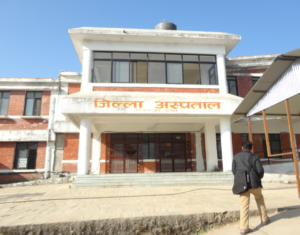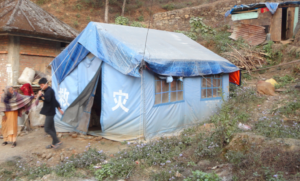The ongoing impact on people’s lives in Nepal of the major earthquakes of April and May 2015

Dr. Radha Adhikari shares her personal observation from visiting Nepal
Two major earthquakes in Nepal, the first on April 25th and the second on May 12th 2015, and hundreds of tremors in between them and thereafter, caused phenomenal devastation in the country. These incidents attracted global attention on Nepal. Within a few hours after the first quake in April, the world’s eyes were glued to social media, as people from most corners of the globe updated their understanding of the disaster. Relief efforts began shortly afterwards and aid started pouring into the country. The only international airport in Kathmandu experienced considerable traffic congestion due to the increasing volume of relief supplies.
This disaster caused total chaos in the lives of the public and damaged many infrastructures, including the health service in Nepal. Recently, in December 2015 and early January 2016, almost eight months after the first quake, I visited Nepal and found people still in deep trauma: psychologically, emotionally and economically. Many public services are still not functioning or are under-functioning. Public life has yet to arrive at a pre-quake stage. People often related their fears and spoke of the emotional ordeal they experienced during the all-too- regular aftershocks, fears that continued for several months after the earthquakes.
Eight months after the earthquakes, I found many health services being conducted in tents, and health professionals are still traumatised. In Sindhupalchok, eight health professionals lost their lives and 14 were reported to have had physical injuries. Long-term damage to the geological and ecological processes is difficult to fully comprehend and estimate. I present here some of my first hand observations and impressions of the medium term impact of the earthquakes on people’s lives in the country.
People’s personal stories psychosocial impact
Initial tremors and aftershocks were felt across the country and a vast majority of people in Nepal experienced them. A young lady, our former neighbour in Kathmandu, seemed still traumatised, as she shared her experiences. Crucially, her life perspectives have changed. Quite philosophically, she commented that “we invest so much in building a house and making it a home, we furnish our homes with the best possible furniture, and try hard to decorate and maintain it. Basically we pour in our emotions, wealth and everything we have to make it home. But during the earthquake, our own home became like our death trap, people did not want to go inside their own homes and do anything inside them. Staying outside was the best option and the safest way to save our lives.” Fortunately her house was spared, but thousands of people lost their relatives, family and properties. Such devastation is visible everywhere in the Kathmandu valley and in the Sindhupalchok district, north-east of the Kathmandu valley.
I heard many stories, from our current landlord and many others, that the fear of further earth tremors still dominates the everyday life of people in Kathmandu valley and in most parts of Nepal. People have lost their spirit, their Atma or soul, and their facial expressions have permanently changed. Basically people’s emotions have been damaged by such a terrifying experience. When they were experiencing those terrible tremors, there was nowhere else to escape to. All those formerly positive, almost jolly and bubbly, people have become like lifeless ghosts of their former selves. Some people behave in quite a short and unfriendly manner, appearing rude without realizing how they are acting. Nabin, our current landlord commented “perhaps internally they feel normal but it is sad to see them changed so much, as to how they behave”.

These were private houses in Chautara town centre, now only rubble is left. Most of this rubble looks as if what remains of people’s homes truly are now death traps…
Impact on health services
While we (a Nepali research colleague and I) visited the district hospital in Sindhupalchok, nursing and midwifery staff we met there suggested that “the rate of pregnant women having miscarriages has increased in our observation”. Health professionals in the district have been noticing an increased number of women attending health facilities in the post-earthquake months. However, they seem to have no proper recording and reporting mechanism yet in place to substantiate this claim. The health system is not back to its pre-earthquake state, so it is difficult to monitor such events and estimate any figure accurately, and perhaps these are not current priorities either, while services are barely functioning. Nursing and midwifery staff also suspect that this is due to the stress of going through such traumatic events.
We visited the district hospital, where Maternal and Child Health clinics have been running in tents for months. Staff member reported that all has been kamchalau meaning a temporary measure or just to get by every day.

The Majestic District Hospital building has been padlocked since the earthquake, as it has been considered unsafe to use.

These tents now serve as male ward, female ward, dispensary, emergency room, counseling room etc.
Many birthing centres (where maternity including child health service is offered to rural people) across the district in Sindhupalchok have been damaged. So many birthing centres are currently non-functioning. Health services, provided by non-governmental organisations in the district have been disrupted too. Staff members are still traumatised, and yet they are providing services while dealing their personal and family’s trauma privately.
Another problem often related to us is the increase in the number of people with mental illness. It is not surprising that a major catastrophe, such as these earthquakes, would trigger mental illnesses in vulnerable people.
Impact on local economy and livelihood
“Paddy fields down in the valley have gone dry, as underground water sources have diverted when earth got shifted. People in Sindhupalchok are finding it difficult to continue their regular livelihood activities; the farmers say that there were not enough water supplies for paddy plantation this year. The freshwater supply in some areas has increased and in other areas the water sources have dried out” said the Chairman of Nagar Bikash Samiti (Town Development Committee) in Chautara. Everybody is having to readjust their lifestyle and livelihood strategies. Some businesses however, have benefited, albeit temporarily. In Chautara for example, business had been good immediately after the earthquake. Because of the scarcity of food and other supplies, people were forced to buy essentials in inflated rate and more money was coming in with the rescue operation. However people who run the business are still in trauma. Managing livelihood has also been kamchalau, any activity has been temporary and mainly for immediate survival.
It is not over yet, all feels raw?
People’s memories seem to be as raw as if it had just happened, and unsure as to how long it will take to heal and recover from such massive devastation.
In Nepal conversation often revolved round the economy having gone into negative figures; people being still traumatized and shaky, and school and hospital services being offered in tents in many parts of the country. The whole nation has been running as kamchalau, taking one day at a time, and working only for immediate survival.
What is happening to western media attention now? That immediate reaction to the first earthquake was just very visible and noteworthy, but has it all started fading away? The most recent earthquake-related news about Nepal in western media was in January 2016, when the finance minister of Nepal at the time of the earthquake received an award as ‘the best Finance Minister in the world’ from a London-based journal named the Banker- http://nepalinsider.com/2016/01/04/heres-why-dr-ram-sharan-mahat-was-named-best-finance-minister/ Apparently this is because he managed to attract the world’s attention and generated a significant amount of funds for rescue and rehabilitation work after the earthquake.
After three weeks in Nepal I came back to Edinburgh, where colleagues and friends asked me about the post earthquake situation in Nepal. I shared my experience with them but their immediate response has been “there has been no news in the western world and Nepal’s agony has already been forgotten”.
When homes turned into a pile of rubble

People live in Kamchalau tents



The earthquake in 2015 claimed over 8000 lives and injured countless more, damaged and destroyed properties and an already fragile infrastructure. As this blog highlights, the earthquake also damaged the Nepalese spirit and sanguine attitude to life. Having lived in Nepal, I am also aware that the Nepalese are resilient and live in hope.
Thanks Ruth. After such a traumatic experience, people certainly have began to move forward, now everybody is very aware of earthquake resistant housing and many new ideas/ policies are put in place.
thanks for sharing information about The ongoing impact on people’s lives in Nepal of the major earthquakes of April and May 2015 with us. so bad day i wish never comeback again in nepal . nepali shayari